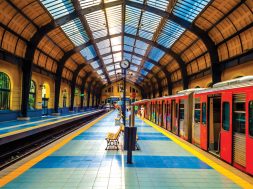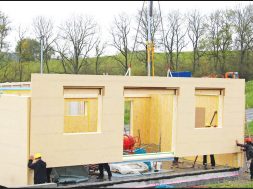The Economics of Green Buildings

Exclusive analysis on economic returns to the investments in green buildings
The green building construction contributes to both global and building economic benefits. In a study carried out by Booz Allen Hamilton, prepared by U.S Green Building Council, the finding indicates that the green construction spending is expected to grow 15.1 per cent, year over year for 2015-2018. In addition, the LEED construction spending is expected to grow 12.3 per cent year over year for 2015-2018.
Whereas the major tangible economic benefit of a green building is energy and water savings – efficiency driven designs and green technologies reduces the operational costs of the building to the tune of 20 to 30 per cent easily, said M Selvarasu, Director at LEAD Consultancy & Engineering Services (I) Pvt Ltd.
Nandana Dilip Kumar, Senior Manager – Sustainable Designs at LEAD Consultancy & Engineering Services (I) Pvt Ltd believes, “There can be significant impact on the property values where prices or rental can be higher than any conventional building construction. Also lowered dependency on the grid power and water supply from local bodies intern supports minimising use of existing infrastructure facility provided by local government to large extent. This leads to overall stable operation of the city, if green concepts are taken for adoption across the city development.”
According to M Anand, Principal Counsellor and a team member of Indian Green Building Council (IGBC) of CII, a green building is one which uses less water, improves energy efficiency, conserves natural resources, generates less waste and provides healthier spaces for occupants, as compared to a conventional building.
Anand explains the benefits of green buildings as:
• 40 to 50 per cent savings in electricity consumption
• 20 to 30 per cent savings in water consumption
• Addresses national priorities: Conservation of natural resources, water efficiency, and energy efficiency, handling of municipal waste and health and well-being of the citizens.
• Intangible benefits: Enhanced ventilation and better views and day lighting.
• Enhanced health and productivity of occupants.
Indian Green Building Council (IGBC) is spearheading the green building movement in India since 2001. As on August, India with over 3.86 billion sq. ft. of green building footprint is the second country in the world in terms of largest registered green building footprint. Over 3,700 projects are adopting IGBC green building rating standards. IGBC aspires to facilitate
10 billion sq. ft. of registered green building footprint by 2022.
Green buildings can be delivered at a price comparable to conventional buildings, with investments recouped through operational cost savings and, with the right design features, create a more productive workplace, says the World Green Building Council.
“In India, many of state governments and its regulatory bodies have already started to give incentives to the developers for making green buildings in terms of extra FSI/ FAR from the range of 5-10 per cent,” informed Mala Singh, Chairperson and MD, PEC Greening India. Some of these agencies include PUDA (Punjab Urban Development Authority), JDA (Jaipur Development Authority), PMC (Pune Municipal Corporation), NDA (Noida Development Authority), and WBDA (West Bengal Development Authority).
The MoEF (Ministry of Environment & Forest) also gives benefit of faster environmental clearance to green building projects which impacts the
net project development cost. Otherwise delay in the approvals also increases the project cost, Mala Singh observes.
Talking on the users’ perspective, Dr. Anil Jindal, CMD, SRS Real Estate illustrates the economic benefits of green buildings as:
Increased property values: Since energy costs are at an all time high, the low cost of operating and the easy maintenance of the green building will make for much lower vacancy rates along with much higher property values.
Water and energy savings: One can see drastic reduction in operating costs that are going to quickly recoup the money invested and will continue to see long term savings. This money can be used for other things beside utility bills.
Sales improvement: Studies have shown that there are better sales in building with more natural light and many retailers are more and more now using day lighting as an effort to bring in huge sales benefits.
Improves employee attendance: Green buildings have control of temperature and ventilation along with increased natural lighting that attribute to improved employee attendance and health. It has been observed that the improvement to indoor environment lowers healthcare costs along with work losses.
Increased employee productivity: Employee productivity will be much better because of the positive indoor environmental conditions. The employees will be sick much less often and will have a better sense of well-being.
Evaluating the ROI in Going ‘Green’
The Return on Investment (ROI) for a green building is very attractive, claims Anand of IGBC. He adds, “One of the reasons why green buildings are widely adopted is the fact that ‘green buildings make good business sense’. Though the incremental cost of a commercial green building would be about 3 to 5 per cent, the additional costs gets paid back within 2 to 3 years with substantial reduction in operational costs. This important proposition is enabling stakeholders go the ‘green’ way.”
Dr. Anil Jindal of SRS Real Estate said, “The period of time required for the return on investment for a green building depends upon the features provided and may range from several months to a few years. As the technologies grow, the time period for the ROI may lessen.”
According to Mala Singh, “The payback period of a green building is indicating a decreasing trend over the years from payback period of 7 years in 2003 to about 1 year or less in 2015. In residential green buildings the extra capital cost is 1-2 per cent only as most of the green compliances are a part of regulatory framework of environment regulations, which gives a very short ROI for residential buildings. In commercial buildings ROI depends on the level of sustainability features incorporated and with type of technologies used. Also, it depends on the type of ownership and operational efficiency. However, in general, the ROI period varies from 1-4 years.”
Explaining the ROI period for a green building, Selvarasu of LEAD Consultancy said, “Since green buildings are influenced by many factors from design to construction, the period of time required for ROI calculation cannot be generalised and will be case-to-case basis.” His colleague Ms. Nandana points out that some of the factors that influence the determination of ROI for a green building are the building size, budget, location, and level of green building certification. Based on these factors the building owner can perform a ROI for determining the number of years as a payback for the features incorporated into the design of a green building, she adds.
However, Selvarasu said, “Based on our experience delivering more than 150 green projects we have worked on, the ROI ranges between 1-5 years depending on the green measures incorporated in the project building. In general, less than 5 years is an ideal ROI for green implementation by considering building life of over 30 years.”
83
Cookie Consent
We use cookies to personalize your experience. By continuing to visit this website you agree to our Terms & Conditions, Privacy Policy and Cookie Policy.









